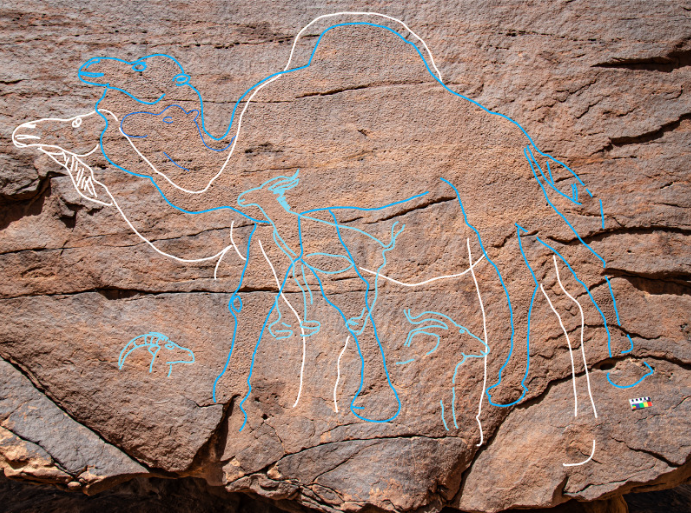Media release
From:
New findings highlight the pioneering role of human groups who lived in the interior of northern Arabia shortly after the hyper-arid conditions of the Last Glacial Maximum (LGM), guided by the return of seasonal water sources – and leaving behind a monumental legacy in rock art.
A team of international archaeologists, led by the Heritage Commission, Saudi Ministry of Culture, and comprising scholars from the Max Planck Institute of Geoanthropology, KAUST (King Abdullah University of Science and Technology), University College London, Griffith University and more – made the discoveries as part of the Green Arabia Project.
The team identified more than 60 rock art panels containing 176 engravings in three previously unexplored areas – Jebel Arnaan, Jebel Mleiha, and Jebel Misma – along the southern edge of the Nefud Desert in northern Saudi Arabia.
The engravings, primarily depicting camels, ibex, equids, gazelles, and aurochs, include 130 life-sized and naturalistic figures, some measuring up to 3m long and more than 2m high.
The engravings date to between 12,800 and 11,400 years ago, a period when seasonal water bodies reappeared in the region following extreme aridity.
These water sources, confirmed through sediment analysis, supported early human expansions into the desert interior and offered rare opportunities for survival.
“These large engravings are not just rock art – they were probably statements of presence, access, and cultural identity,” said lead author, Dr Maria Guagnin from Max Planck Institute of Geoanthropology.
Dr Ceri Shipton, co-lead author from the Institute of Archaeology, University College London, said: “The rock art marks water sources and movement routes, possibly signifying territorial rights and intergenerational memory.”
Unlike previously known sites where engravings were hidden in crevices, the Jebel Mleiha and the Jebel Arnaan panels were etched onto towering cliff faces, some up to 39 meters high, in visually commanding locations.
One panel would have required ancient artists to climb and work precariously on narrow ledges, underscoring the sheer effort and significance of the imagery.
Artefacts including Levantine-style El Khiam and Helwan stone points, green pigment, and dentalium beads suggest long-distance connections to Pre-Pottery Neolithic (PPN) populations in the Levant region.
However, the scale, content, and placement of the Arabian engravings set them apart.
“This unique form of symbolic expression belongs to a distinct cultural identity adapted to life in a challenging, arid environment,” said Dr Faisal Al-Jibreen, from the Heritage Commmission, Saudi Ministry of Culture.
“The project’s interdisciplinary approach has begun to fill a critical gap in the archaeological record of northern Arabia between the LGM and the Holocene, shedding light on the resilience and innovation of early desert communities,” said Michael Petraglia, lead of the Green Arabia project.
The study ‘Monumental rock art illustrates that humans thrived in the Arabian Desert during the Pleistocene-Holocene transition’ has been published in Nature Communications.



 Australia; QLD
Australia; QLD


